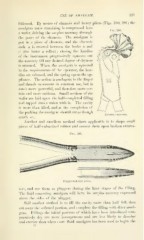Page 323 - My FlipBook
P. 323
USE OF AMALGAM. 321
followed. By means of chamois and heavy pliers (Figs. 290, 291) the
amalgam mass remaining is compressed into
a wafer, driving the surplus mercury through
the pores of the chamois. The amalgam is
put in a piece of chamois, and the chamois
sack A is entered between the beaks n and
C (the latter a roller) ; closing the handles
of the instrument progressively squeezes out
the mercury till any desired degree of dryness
is attained. "When the amalgam is squeezed
to the requirements of the operator, the han-
dles are released, and the spring opens the ap-
pliance. The action is analogous to the finger
and thumb movement in common use, but is
much more powerful, and therefore more cer-
tain and more uniform. Small sections of the
wafer are laid ujion the half-completed filling
and tapped into a union with it. The cavity
is more than filled, and at the completion of
the packing the amalgam should cut as though
Mercury expresser.
nearly set.
Another and excellent method where applicable is to shape small
pieces of half-vulcanized rubber and cement them upon broken excava-
FiG. 291.
Flagg's wafering pliers.
tors, and use them as pluggers during the later stages of the filling,
The fluid cementing amalgam will have its surplus mercury expressed
about the sides of the plugger.
Still another method is to fill the cavity more than half full, then
cut away the softened portion, and complete the filling with drier amal-
gam. Fillings the initial portions of which have been introduced corn-
paratively dry are more homogeneous and are less likely to discolor
and crevice than when more fluid amalgam has been used to begin the
21


